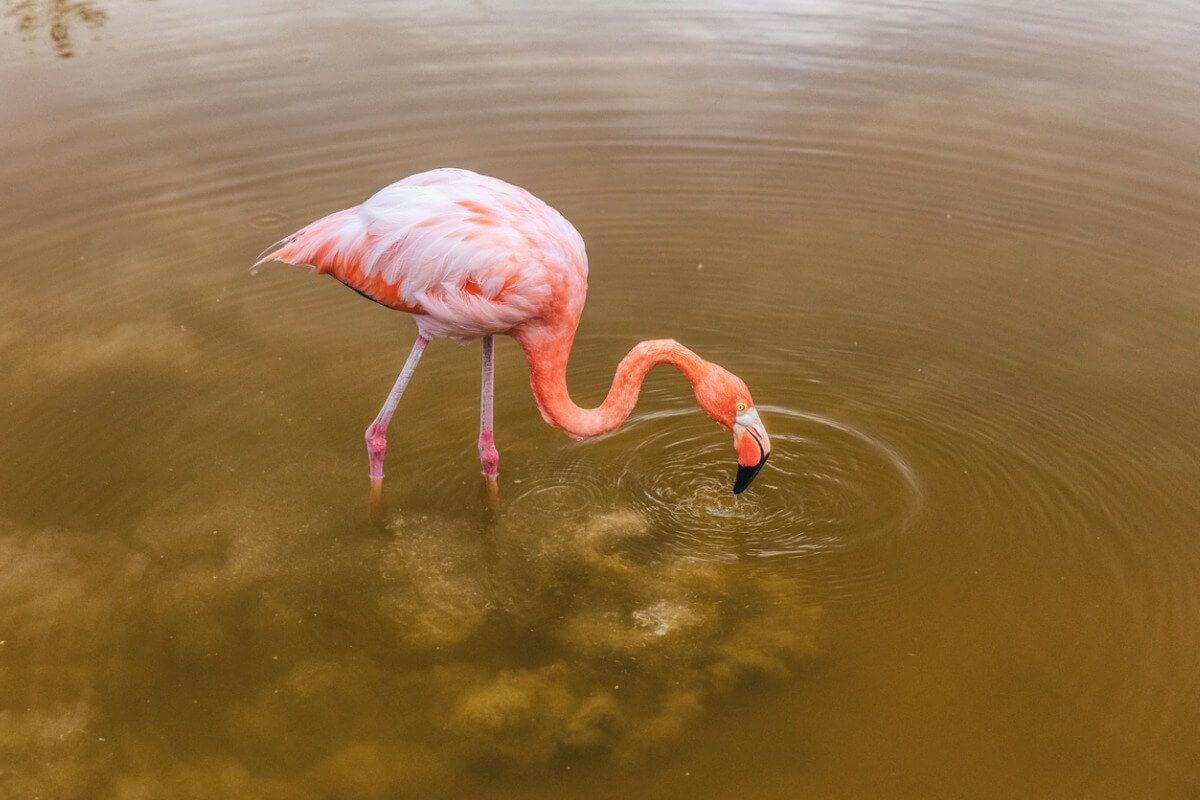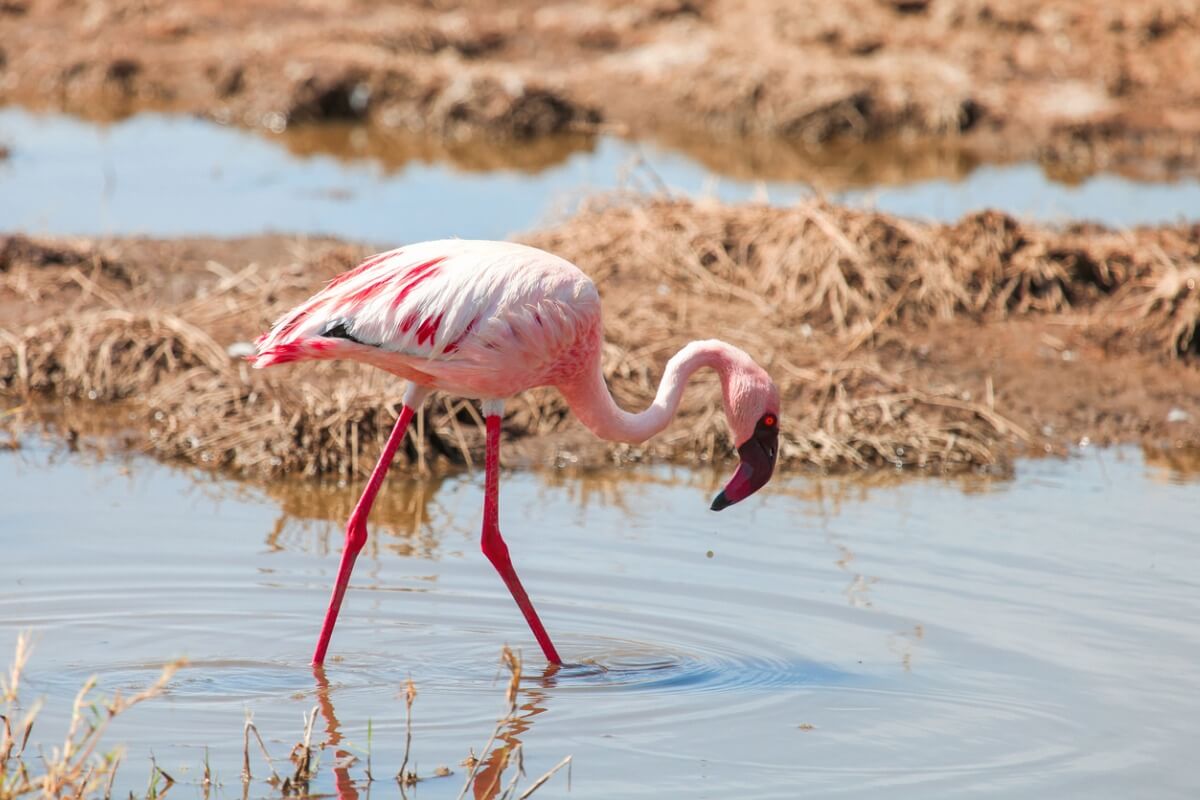Why Are Flamingos Pink?


Reviewed and approved by the biologist Samuel Sanchez
There are 6 species of flamingos and each of them has different habits and characteristics, such as the color of their feathers. The common flamingo (Phoenicopterus roseus) is the tallest, its feathers are paler and its beak is pink. On the other hand, the lesser flamingo (Phoeniconaias minor) is the smallest of its group and has several different shades. Today we’ll be asking the interesting question: why are flamingos pink?
The color of flamingos is a fascinating topic. Moreover, some of these birds are pinker than others, but why is that? If you want to know the reason for this wonderful body tone, read on.
Flamingo characteristics
Flamingos are a bird that belong to the Phoenicopteridae family, the only group of birds in the order Phoenicopteriformes. There are 4 species distributed throughout the Americas (including the Caribbean) and 2 species are native to Africa, Asia, and Europe.
These 6 existing species were previously placed in a single genus (Phoenicopterus ), but nowadays the family has 3 recognized genera. These are the flamingos you can meet today:
- The common flamingo (Phoenicopterus roseus)
- Lesser Flamingo (Phoeniconaias minor)
- Chilean or southern flamingo (Phoenicopterus chilensis)
- James’s flamingo (Phoenicoparrus jamesi)
- Andean flamingo (Phoenicoparrus andinus)
- Caribbean flamingo or red flamingo (Phoenicopterus ruber)
These birds are well known not only for their color, but also because they they’re usually seen standing on one leg while the other is placed under the body. Experts say that flamingos usually spend a lot of time in this position (until they fall asleep).
It may surprise you, but flamingos can fly (but they usually do it at night) and they’re also considered very noisy birds. There are even variations in vocalizations between the different species that allow them to recognise each other.
Another very interesting feature about these birds is that they’re very social and live in colonies of thousands. It’s believed that this large number in groupings serves to avoid predation, maximize food intake, and utilize unsuitable nesting sites successfully.

Where does the pink color of flamingos come from?
Have you heard the expression “we are what we eat”? Well, flamingos take it to the extreme. Their pink color is explained by carotenoids, organic pigments found naturally in plants and other organisms such as algae, some kinds of fungi, and bacteria.
Carotenoids give carrots their orange color and turn ripe tomatoes red. In addition, these organic pigments are also found in the microscopic algae that shrimp eat. By feeding on algae and shrimp, flamingos metabolize the pigments in such a way that their feathers turn pink.
The diet of flamingos
Flamingos feed on algae, small seeds, tiny crustaceans (such as brine shrimp), fly larvae, other plants and animals that live in shallow water, making them omnivores. Their beaks are specially adapted to separate mud from the food they eat and they use them in a quite unique way.
When filter feeding, flamingos place their heads upside down in the water with their beaks toward their feet to eat. They then sweep their cephalic structures from side to side and use their tongues to pump water in and out of their beaks.
The comb-like plates on the edge of the bird’s beak create a filter for the water to exit while trapping the food inside. The filtering of food is assisted by hairy structures called lamellae, which line the flamingo’s jaw and tongue.
Flamingo color by species
Caribbean flamingos (Phoenicopterus ruber) have a brighter red color than others in their family due to the availability of carotenoids in their food. On the other hand, lesser flamingos (Phoeniconaias minor) are a paler pink, as they ingest a smaller amount of this pigment.
As you know, carotenoids are broken down into pigments. However, the consumption of these pigments varies from species to species, which affects color saturation. For example, flamingos whose only diet is blue-green algae are darker than those who get them second-hand by eating animals that have already digested them.
Are flamingos born pink?
The BBC reports that flamingos aren’t born pink, but acquire this shade over time. When they first come into the world, these birds are grey or white and turn pink during the first years of their lives. As adults, the pink varies from light to bright red, depending on the food supply and the characteristics of each individual.
The word “flamingo” comes from the Latin word flamenco, which means fire, and refers to the bright color of the birds’ feathers. However, in 2015 (in Cyprus) the existence of a black flamingo became known. It’s believed that this animal suffered from melanism, an excess of dark pigmentation that occurs relatively frequently in individuals of various species.
Aggressiveness according to the color of the flamingos
National Geographic states that, according to a study published on May 8, 2020, flamingos with a more intense pink color tend to be more aggressive. In addition, birds with a pinker plumage are healthier and more likely to attract a mate.
In these birds, color plays a very important role in their social relationships, as the tone of their plumage is a sign that these animals are healthy and fit. Those with the pinkest colors are more likely to initiate confrontations and fight for social status, as indicated by the sources cited above.
Healthy (and therefore pinker) flamingos eat efficiently, as they dominate food areas and are aggressive towards others when searching for food. Because they control group situations, these fitter birds ensure the preservation of their pinkish hues and attract equally colorful mates.
In many species, animals with brighter colors (from eating carotenoids) have superior feeding abilities and are in better health and physical condition. The females interpret this during the breeding season, so they always look for the most conspicuous males.
Current status
None of the 6 species of flamingos are considered endangered. However, they are animals that have been exploited by humans and experience threats today, such as hunting, egg collecting, climate change, and habitat destruction and degradation.

Now that you know why these wonderful birds are so colorful, it’s time to contribute to their conservation and spread the word about their prodigious nature. Otherwise, in a few centuries, we may no longer be able to enjoy their pinkish tones.
There are 6 species of flamingos and each of them has different habits and characteristics, such as the color of their feathers. The common flamingo (Phoenicopterus roseus) is the tallest, its feathers are paler and its beak is pink. On the other hand, the lesser flamingo (Phoeniconaias minor) is the smallest of its group and has several different shades. Today we’ll be asking the interesting question: why are flamingos pink?
The color of flamingos is a fascinating topic. Moreover, some of these birds are pinker than others, but why is that? If you want to know the reason for this wonderful body tone, read on.
Flamingo characteristics
Flamingos are a bird that belong to the Phoenicopteridae family, the only group of birds in the order Phoenicopteriformes. There are 4 species distributed throughout the Americas (including the Caribbean) and 2 species are native to Africa, Asia, and Europe.
These 6 existing species were previously placed in a single genus (Phoenicopterus ), but nowadays the family has 3 recognized genera. These are the flamingos you can meet today:
- The common flamingo (Phoenicopterus roseus)
- Lesser Flamingo (Phoeniconaias minor)
- Chilean or southern flamingo (Phoenicopterus chilensis)
- James’s flamingo (Phoenicoparrus jamesi)
- Andean flamingo (Phoenicoparrus andinus)
- Caribbean flamingo or red flamingo (Phoenicopterus ruber)
These birds are well known not only for their color, but also because they they’re usually seen standing on one leg while the other is placed under the body. Experts say that flamingos usually spend a lot of time in this position (until they fall asleep).
It may surprise you, but flamingos can fly (but they usually do it at night) and they’re also considered very noisy birds. There are even variations in vocalizations between the different species that allow them to recognise each other.
Another very interesting feature about these birds is that they’re very social and live in colonies of thousands. It’s believed that this large number in groupings serves to avoid predation, maximize food intake, and utilize unsuitable nesting sites successfully.

Where does the pink color of flamingos come from?
Have you heard the expression “we are what we eat”? Well, flamingos take it to the extreme. Their pink color is explained by carotenoids, organic pigments found naturally in plants and other organisms such as algae, some kinds of fungi, and bacteria.
Carotenoids give carrots their orange color and turn ripe tomatoes red. In addition, these organic pigments are also found in the microscopic algae that shrimp eat. By feeding on algae and shrimp, flamingos metabolize the pigments in such a way that their feathers turn pink.
The diet of flamingos
Flamingos feed on algae, small seeds, tiny crustaceans (such as brine shrimp), fly larvae, other plants and animals that live in shallow water, making them omnivores. Their beaks are specially adapted to separate mud from the food they eat and they use them in a quite unique way.
When filter feeding, flamingos place their heads upside down in the water with their beaks toward their feet to eat. They then sweep their cephalic structures from side to side and use their tongues to pump water in and out of their beaks.
The comb-like plates on the edge of the bird’s beak create a filter for the water to exit while trapping the food inside. The filtering of food is assisted by hairy structures called lamellae, which line the flamingo’s jaw and tongue.
Flamingo color by species
Caribbean flamingos (Phoenicopterus ruber) have a brighter red color than others in their family due to the availability of carotenoids in their food. On the other hand, lesser flamingos (Phoeniconaias minor) are a paler pink, as they ingest a smaller amount of this pigment.
As you know, carotenoids are broken down into pigments. However, the consumption of these pigments varies from species to species, which affects color saturation. For example, flamingos whose only diet is blue-green algae are darker than those who get them second-hand by eating animals that have already digested them.
Are flamingos born pink?
The BBC reports that flamingos aren’t born pink, but acquire this shade over time. When they first come into the world, these birds are grey or white and turn pink during the first years of their lives. As adults, the pink varies from light to bright red, depending on the food supply and the characteristics of each individual.
The word “flamingo” comes from the Latin word flamenco, which means fire, and refers to the bright color of the birds’ feathers. However, in 2015 (in Cyprus) the existence of a black flamingo became known. It’s believed that this animal suffered from melanism, an excess of dark pigmentation that occurs relatively frequently in individuals of various species.
Aggressiveness according to the color of the flamingos
National Geographic states that, according to a study published on May 8, 2020, flamingos with a more intense pink color tend to be more aggressive. In addition, birds with a pinker plumage are healthier and more likely to attract a mate.
In these birds, color plays a very important role in their social relationships, as the tone of their plumage is a sign that these animals are healthy and fit. Those with the pinkest colors are more likely to initiate confrontations and fight for social status, as indicated by the sources cited above.
Healthy (and therefore pinker) flamingos eat efficiently, as they dominate food areas and are aggressive towards others when searching for food. Because they control group situations, these fitter birds ensure the preservation of their pinkish hues and attract equally colorful mates.
In many species, animals with brighter colors (from eating carotenoids) have superior feeding abilities and are in better health and physical condition. The females interpret this during the breeding season, so they always look for the most conspicuous males.
Current status
None of the 6 species of flamingos are considered endangered. However, they are animals that have been exploited by humans and experience threats today, such as hunting, egg collecting, climate change, and habitat destruction and degradation.

Now that you know why these wonderful birds are so colorful, it’s time to contribute to their conservation and spread the word about their prodigious nature. Otherwise, in a few centuries, we may no longer be able to enjoy their pinkish tones.
All cited sources were thoroughly reviewed by our team to ensure their quality, reliability, currency, and validity. The bibliography of this article was considered reliable and of academic or scientific accuracy.
BBC. (2019, 17 enero). Why are flamingos pink? – CBBC Newsround. https://www.bbc.co.uk/newsround/40964645
Elcacho, J. (2015, 9 abril). El mito del flamenco negro se hace realidad en un estanque de Chipre. La Vanguardia. https://www.lavanguardia.com/natural/20150409/54429504983/descubren-flamenco-negro-estanque-chipre.html
Morell, V. (2020, 9 junio). El color más rosáceo de estas aves es un indicador de buena salud y es seductor para las parejas, pero también significa que es más probable que se peleen por la comida. National Geographic. https://www.nationalgeographic.es/animales/2020/06/los-flamencos-mas-rosados-son-mas-agresivos
Smithsonian’s National Zoo & Conservation Biology Institute. (2021, 29 junio). Why are Flamingos Pink? And Other Flamingo Facts. Smithsonian’s National Zoo. https://nationalzoo.si.edu/animals/news/why-are-flamingos-pink-and-other-flamingo-facts
Wikipedia contributors. (2021, 25 agosto). Flamingo. Wikipedia. https://en.wikipedia.org/wiki/Flamingo#Species
This text is provided for informational purposes only and does not replace consultation with a professional. If in doubt, consult your specialist.








